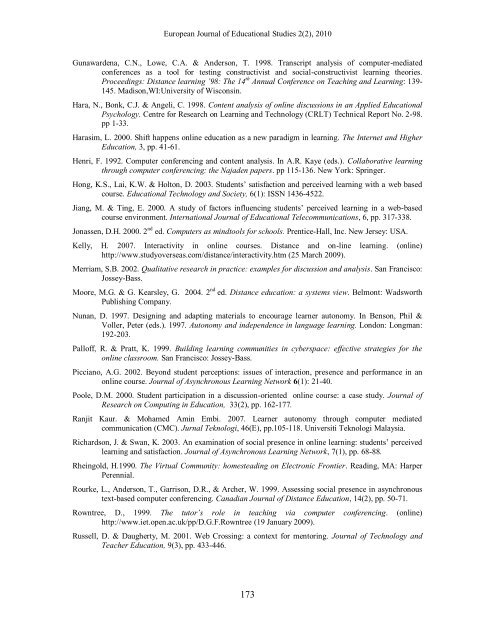Educational - Ozean Publications
Educational - Ozean Publications
Educational - Ozean Publications
You also want an ePaper? Increase the reach of your titles
YUMPU automatically turns print PDFs into web optimized ePapers that Google loves.
European Journal of <strong>Educational</strong> Studies 2(2), 2010Gunawardena, C.N., Lowe, C.A. & Anderson, T. 1998. Transcript analysis of computer-mediatedconferences as a tool for testing constructivist and social-constructivist learning theories.Proceedings: Distance learning ’98: The 14 th Annual Conference on Teaching and Learning: 139-145. Madison,WI:University of Wisconsin.Hara, N., Bonk, C.J. & Angeli, C. 1998. Content analysis of online discussions in an Applied <strong>Educational</strong>Psychology. Centre for Research on Learning and Technology (CRLT) Technical Report No. 2-98.pp 1-33.Harasim, L. 2000. Shift happens online education as a new paradigm in learning. The Internet and HigherEducation, 3, pp. 41-61.Henri, F. 1992. Computer conferencing and content analysis. In A.R. Kaye (eds.). Collaborative learningthrough computer conferencing: the Najaden papers. pp 115-136. New York: Springer.Hong, K.S., Lai, K.W. & Holton, D. 2003. Students‟ satisfaction and perceived learning with a web basedcourse. <strong>Educational</strong> Technology and Society, 6(1): ISSN 1436-4522.Jiang, M. & Ting, E. 2000. A study of factors influencing students‟ perceived learning in a web-basedcourse environment. International Journal of <strong>Educational</strong> Telecommunications, 6, pp. 317-338.Jonassen, D.H. 2000. 2 nd ed. Computers as mindtools for schools. Prentice-Hall, Inc. New Jersey: USA.Kelly, H. 2007. Interactivity in online courses. Distance and on-line learning. (online)http://www.studyoverseas.com/distance/interactivity.htm (25 March 2009).Merriam, S.B. 2002. Qualitative research in practice: examples for discussion and analysis. San Francisco:Jossey-Bass.Moore, M.G. & G. Kearsley, G. 2004. 2 nd ed. Distance education: a systems view. Belmont: WadsworthPublishing Company.Nunan, D. 1997. Designing and adapting materials to encourage learner autonomy. In Benson, Phil &Voller, Peter (eds.). 1997. Autonomy and independence in language learning. London: Longman:192-203.Palloff, R. & Pratt, K. 1999. Building learning communities in cyberspace: effective strategies for theonline classroom. San Francisco: Jossey-Bass.Picciano, A.G. 2002. Beyond student perceptions: issues of interaction, presence and performance in anonline course. Journal of Asynchronous Learning Network 6(1): 21-40.Poole, D.M. 2000. Student participation in a discussion-oriented online course: a case study. Journal ofResearch on Computing in Education, 33(2), pp. 162-177.Ranjit Kaur. & Mohamed Amin Embi. 2007. Learner autonomy through computer mediatedcommunication (CMC). Jurnal Teknologi, 46(E), pp.105-118. Universiti Teknologi Malaysia.Richardson, J. & Swan, K. 2003. An examination of social presence in online learning: students‟ perceivedlearning and satisfaction. Journal of Asynchronous Learning Network, 7(1), pp. 68-88.Rheingold, H.1990. The Virtual Community: homesteading on Electronic Frontier. Reading, MA: HarperPerennial.Rourke, L., Anderson, T., Garrison, D.R., & Archer, W. 1999. Assessing social presence in asynchronoustext-based computer conferencing. Canadian Journal of Distance Education, 14(2), pp. 50-71.Rowntree, D., 1999. The tutor’s role in teaching via computer conferencing. (online)http://www.iet.open.ac.uk/pp/D.G.F.Rowntree (19 January 2009).Russell, D. & Daugherty, M. 2001. Web Crossing: a context for mentoring. Journal of Technology andTeacher Education, 9(3), pp. 433-446.173
















